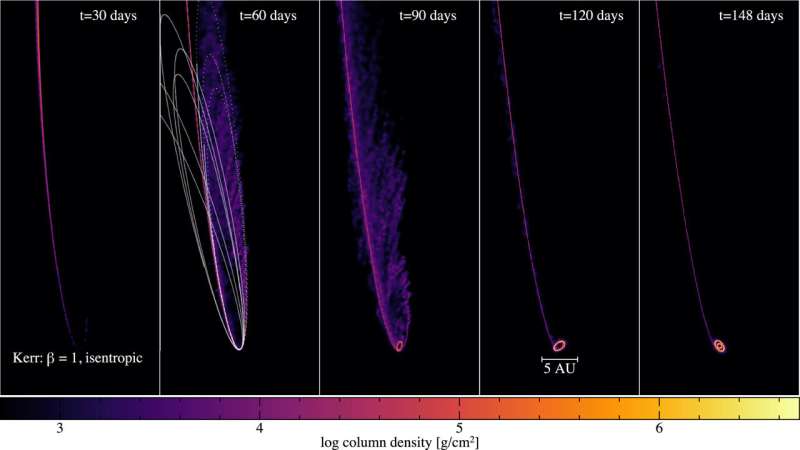This article has been reviewed according to Science X's editorial process and policies. Editors have highlighted the following attributes while ensuring the content's credibility:
fact-checked
peer-reviewed publication
trusted source
proofread
New simulations shed light on stellar destruction by supermassive black holes

Monash University astronomers have contributed to a breakthrough in understanding the dramatic fate of stars that wander too close to supermassive black holes at the centers of galaxies.
Through innovative simulations, an international research team, led by Professor Daniel Price and former student David Liptai from the School of Physics and Astronomy has captured the complex process of how these stars are torn apart and consumed by black holes, providing new insights into the mysterious optical and UV emissions observed during these catastrophic events.
"This is the first self-consistent simulation of a star being tidally disrupted by a supermassive black hole, followed by the evolution of the resulting debris over the course of a year," Professor Price said.
"Our simulations provide a new perspective on the final moments of stars in the vicinity of supermassive black holes," he said.
"By capturing the full evolution of the debris, we can try to connect simulations to the growing number of observed star-shredding events identified with telescope surveys"
The study, published in The Astrophysical Journal Letters, is a significant step forward in astrophysics, opening new avenues for research into the behavior of matter in extreme gravitational fields and the life cycles of stars and black holes.
When a star passes too close to a supermassive black hole, the intense gravitational forces pull it apart in a process known as a tidal disruption event (TDE). The debris from the star forms a stream that eventually feeds the black hole. The debris from the star forms a swirling disk around the black hole, which emits intense radiation across the electromagnetic spectrum. However, many aspects of TDEs remain poorly understood.
The new simulations show that this debris forms an asymmetric bubble around the black hole, reprocessing the energy and producing the observed light curves with lower temperatures, fainter luminosities, and gas velocities of 10,000–20,000 km/s.
"The study helps to explain several puzzling properties of observed TDEs," Professor Price said. "A good analogy is the human body: when we eat lunch, our body temperature does not change much. This is because we reprocess the energy from lunch into infrared wavelengths.
"A TDE is similar, we mostly do not see the black hole stomach eating gas, because it is smothered by material that reemits at optical wavelengths. Our simulations show how this smothering occurs."

Other mysteries explained by the new simulations include:
- Why tidal disruption events are observed at optical rather than X-ray wavelengths, where X-rays would be expected from accretion onto a supermassive black hole.
- Why the temperatures observed are consistent with the photosphere of a star rather than the expected hot accretion disk.
- Why observed star-shredding events are fainter than expected from models of black holes efficiently eating material.
- Why the spectra of observed events find material expanding towards us at a few percent of the speed of light (10–20,000 km/s).
The research team used the advanced smoothed particle hydrodynamics code Phantom, incorporating general relativistic effects to simulate the dynamics of the star and the debris accurately. This level of detail is crucial for capturing the complex interactions and energy dissipation processes that occur during and after the star's disruption.
"The findings confirm the theoretical existence of Eddington envelopes, which act as a reprocessing layer for the emitted energy, explaining the optical and ultraviolet emission observed during TDEs," Professor Price said.
"This model also offers a potential explanation for the observed differences in X-ray and optical lightcurves from these events, suggesting that varying viewing angles might account for these discrepancies."
More information: Daniel J. Price et al, Eddington Envelopes: The Fate of Stars on Parabolic Orbits Tidally Disrupted by Supermassive Black Holes, The Astrophysical Journal Letters (2024). DOI: 10.3847/2041-8213/ad6862
Journal information: Astrophysical Journal Letters
Provided by Monash University



















